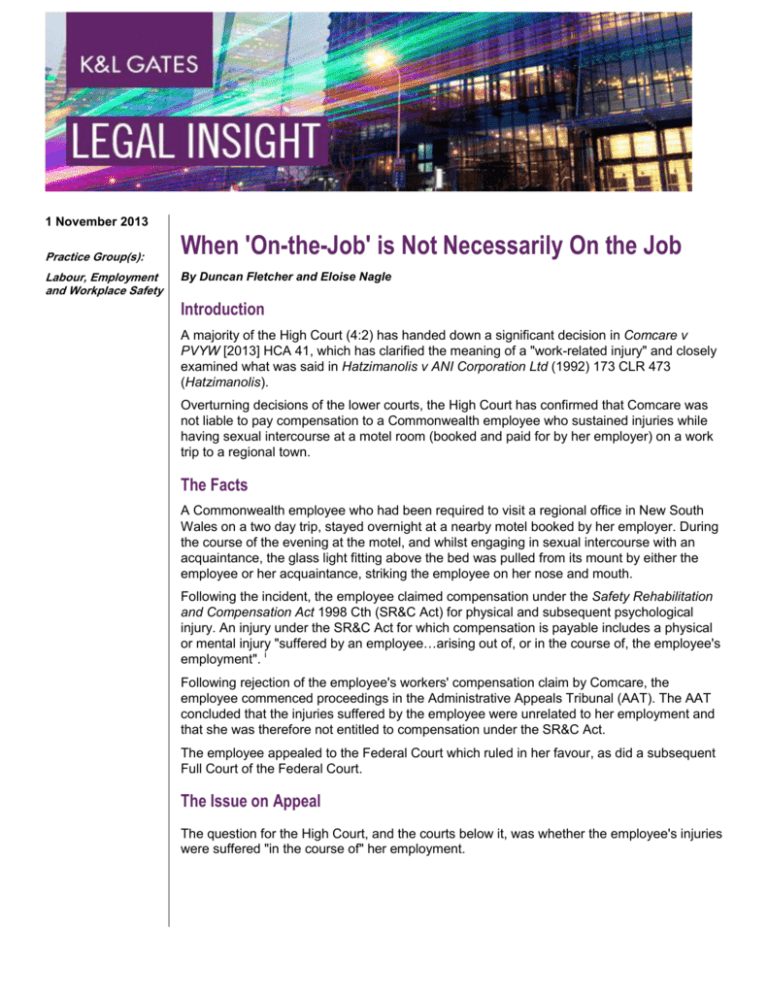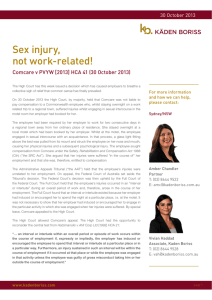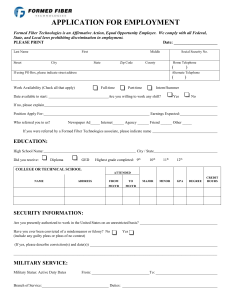
1 November 2013
Practice Group(s):
Labour, Employment
and Workplace Safety
When 'On-the-Job' is Not Necessarily On the Job
By Duncan Fletcher and Eloise Nagle
Introduction
A majority of the High Court (4:2) has handed down a significant decision in Comcare v
PVYW [2013] HCA 41, which has clarified the meaning of a "work-related injury" and closely
examined what was said in Hatzimanolis v ANI Corporation Ltd (1992) 173 CLR 473
(Hatzimanolis).
Overturning decisions of the lower courts, the High Court has confirmed that Comcare was
not liable to pay compensation to a Commonwealth employee who sustained injuries while
having sexual intercourse at a motel room (booked and paid for by her employer) on a work
trip to a regional town.
The Facts
A Commonwealth employee who had been required to visit a regional office in New South
Wales on a two day trip, stayed overnight at a nearby motel booked by her employer. During
the course of the evening at the motel, and whilst engaging in sexual intercourse with an
acquaintance, the glass light fitting above the bed was pulled from its mount by either the
employee or her acquaintance, striking the employee on her nose and mouth.
Following the incident, the employee claimed compensation under the Safety Rehabilitation
and Compensation Act 1998 Cth (SR&C Act) for physical and subsequent psychological
injury. An injury under the SR&C Act for which compensation is payable includes a physical
or mental injury "suffered by an employee…arising out of, or in the course of, the employee's
employment". i
Following rejection of the employee's workers' compensation claim by Comcare, the
employee commenced proceedings in the Administrative Appeals Tribunal (AAT). The AAT
concluded that the injuries suffered by the employee were unrelated to her employment and
that she was therefore not entitled to compensation under the SR&C Act.
The employee appealed to the Federal Court which ruled in her favour, as did a subsequent
Full Court of the Federal Court.
The Issue on Appeal
The question for the High Court, and the courts below it, was whether the employee's injuries
were suffered "in the course of" her employment.
When 'On-the-Job' is Not Necessarily On the Job
Applying the Hatzimanolis Principle
In making its decision, the High Court considered and applied the legal reasoning and
principle stated in Hatzimanolis.
The principle in Hatzimanolis is centered on what the employer might have induced or
encouraged the employee to do. It is that inducement or encouragement which creates an
association or connection with the employee's employment.
In that case, Mr. Hatzimanolis was employed to work on a mine for six days each week and
possibly on some Sundays. His employer provided him accommodation and supplied
vehicles and transport to and from the mine. One Sunday, when not working, Mr
Hatzimanolis participated in an employer-organised social trip. On the return journey, the
work vehicle he was travelling in overturned, causing Mr Hatzimanolis serious injury.
The Court in Hatzimanolis identified two circumstances in which an injury may be regarded
as sustained "in the course of" the employee's employment:
where an injury was suffered by an employee whilst engaged in an 'activity' in which the
employer had induced or encouraged the employee to engage; or
where an injury was suffered at and by reference to a 'place' where the employer had
induced or encouraged the employee to be.
Connection Between the Injury and the Employer's "Inducement or
Encouragement"
The decision of Hatzimanolis has stood for over 20 years. It is a decision which has long
provided a legal justification for making an injury, which occurred between periods of actual
work, compensable by classifying the period between actual work as being "during the
course of employment" and characterising the interval by reference to the employer's
inducement or encouragement.
Injury and activity
Applying the reasoning in Hatzimanolis, the High Court held that where the circumstances of
the injury involves the employee engaging in an activity (as they did here, the activity being
sexual intercourse), the question will be whether the employer induced or encouraged the
employee to engage in that activity, not whether the employer induced or encouraged the
employee to be present at a place.
The majority held that clearly, the answer to the above question was "no" – her employer did
not induce or encourage her to engage in sexual intercourse.
Injury and place
The High Court further held that an injury occurring to an employee by reference to, or
associated with, a place may involve something occurring to the premises or some defect in
the premises.
The High Court gave the example that, if the light fitting, in this case, had been insecurely
fastened into place and simply fell upon the employee, her injury would have arisen by
reference to the motel and her employer would be responsible for her injury because it had
put her in a position where the injury occurred.
2
When 'On-the-Job' is Not Necessarily On the Job
It follows that liability in the above example, would be justifiable, but liability for everything
that occurs while an employee is present at a place, is not.
Significance for Employers
The High Court's decision has clarified the principle in Hatzimanolis that, for an injury
occurring in an interval during a period of work to be "in the course of employment", the
circumstance in which an employee is injured must be connected to the inducement or
encouragement of the employer.
As the majority held:
"An inducement or encouragement to be at a particular place does not provide the
necessary connection to employment merely because an employee is injured whilst
engaged in an activity at that place"ii
While the principles derived from Hatzimanolis remain, this recent decision narrows its
application. The decision, which has implications broader than its impact on the
Commonwealth insurance scheme, will be welcomed by employers across all jurisdictions. It
places a limit on an employer's liability where an employee may claim compensation for
injuries sustained in an overall period of work, including relevantly, where an employee
participates in work related activities, such as travel, outside the confines of the usual work
environment, and partakes in activities which are not 'induced or encouraged' by their
employer.
Further information
Comcare v PVYW [2013] HCA 41 (30 October 2013)
Author:
Duncan Fletcher
duncan.fletcher@klgates.com
+61.8.9216.0923
Eloise Nagle
eloise.nagle@klgates.com
+61.8.9216.0950
3
When 'On-the-Job' is Not Necessarily On the Job
Anchorage Austin Beijing Berlin Boston Brisbane Brussels Charleston Charlotte Chicago Dallas Doha Dubai Fort Worth Frankfurt
Harrisburg Hong Kong Houston London Los Angeles Melbourne Miami Milan Moscow Newark New York Orange County Palo Alto Paris
Perth Pittsburgh Portland Raleigh Research Triangle Park San Diego San Francisco São Paulo Seattle Seoul Shanghai Singapore Spokane
Sydney Taipei Tokyo Warsaw Washington, D.C. Wilmington
K&L Gates practices out of 48 fully integrated offices located in the United States, Asia, Australia, Europe, the
Middle East and South America and represents leading global corporations, growth and middle-market companies,
capital markets participants and entrepreneurs in every major industry group as well as public sector entities,
educational institutions, philanthropic organizations and individuals. For more information about K&L Gates or its
locations, practices and registrations, visit www.klgates.com.
This publication is for informational purposes and does not contain or convey legal advice. The information herein should not be used or relied upon in
regard to any particular facts or circumstances without first consulting a lawyer.
©2013 K&L Gates LLP. All Rights Reserved.
i
ii
Safety, Rehabilitation and Compensation Act 1988, ss 4(1), 5A(1)(b).
Comcare v PVYW [2013] HCA 41, 60.
4








